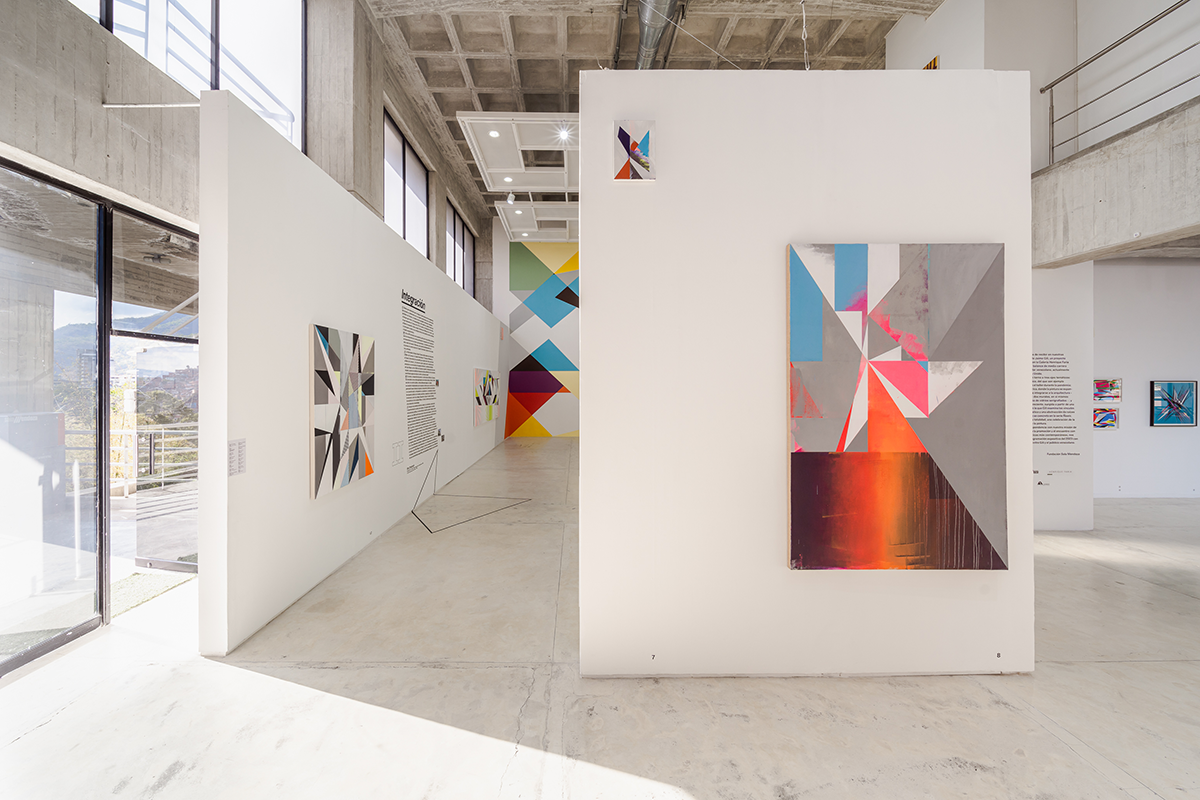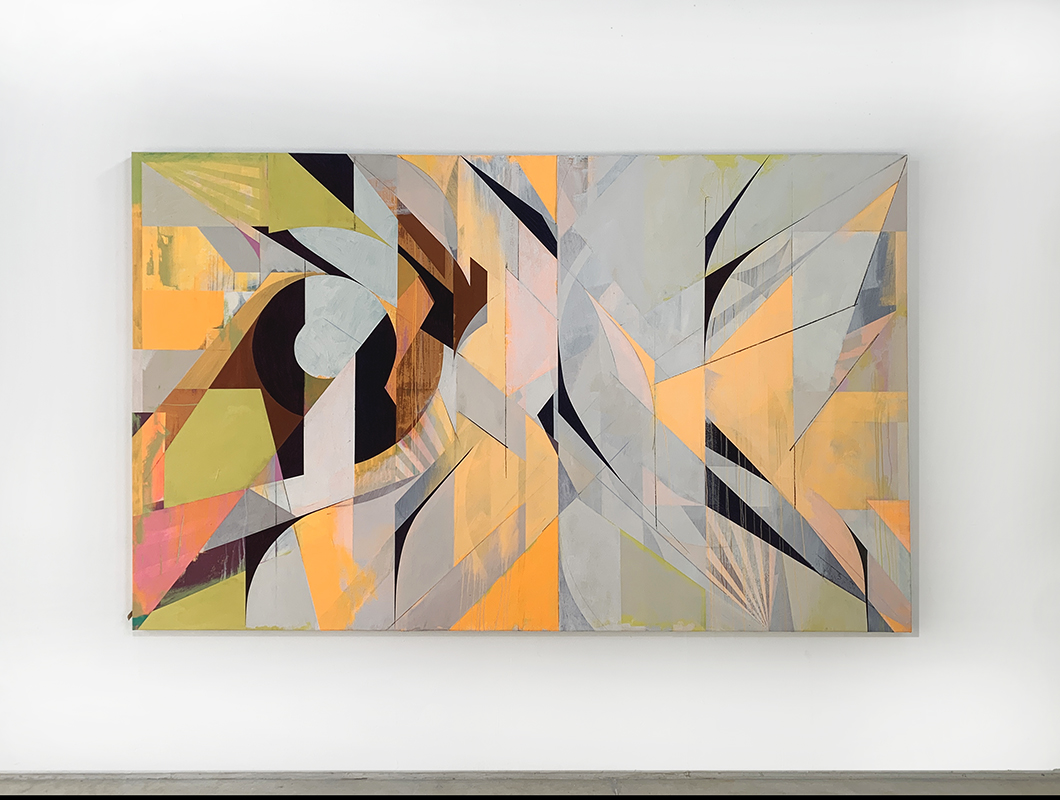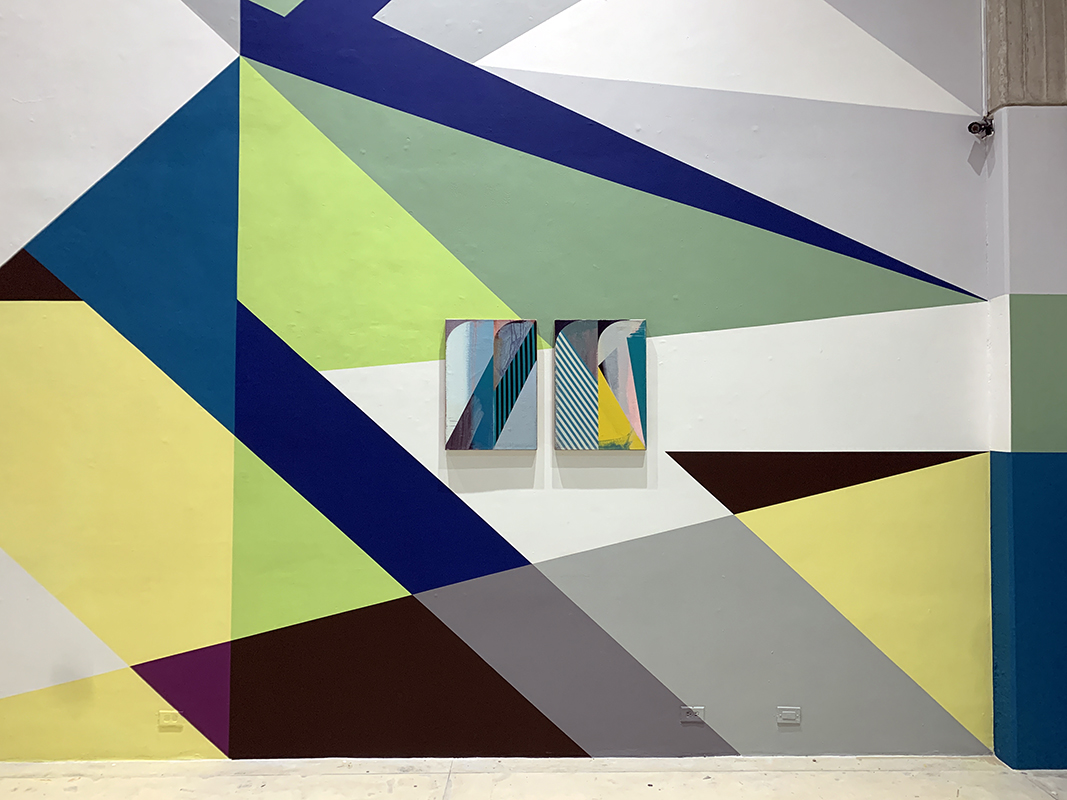OJO
Sala Mendoza, Caracas
(With Henrique Faría New York)
2023
photos 1-6 outer___vision
photos 7-10 Jaime Gili Studio
This exhibition has been developed in partnership with the Henrique Faria, New York, and comprises 60 works, small, medium and large canvases, editions, as well as a monumental mural measuring 7 x 8 meters and an installation of modular glass panels. The selection is articulated around three axes: painting itself, as limited by the canvas; the painting-architecture relationship; and a third one, about the links with more universal forms of abstraction. The three mix and dialogue within the gallery spaces, acquiring the installational dimension common in Gili´s work.
From the press release: Heir to the Latin American abstract-geometric tradition, Gili, who lives in London, meets the Venezuelan public -after a pause of a decade- with this exhibition specially conceived for Sala Mendoza, where he masterfully explores one of his recurring concerns, painting inside and outside the canvas. With this mid-career review, which visits the painter's production since the year 2009 to 2023, Sala Mendoza begins its 2023 exhibition program celebrating the strength of painting. An unmissable opportunity to enjoy a excellent sample of Venezuelan contemporary art.
OJO is crossed by three axes. Two that are fundamental and constant in the work of Jaime Gili -painting inside and outside the canvas- and a third front, recently opened by the artist in a residence in Bolivia, which is that of the relationship of his painting with an abstraction of universal roots.
In his text, which presents the first part of the show, Juan Carlos Ledezma writes "The element that in these works is reiterates more insistently is an angular shape that can be interpreted like the repellency of the angles of the pictorial support. Thus the edge or limit of said support is incorporated into the interior of the work, where it is fragmented and multiplied according to its repellent mechanics. This underlines the close relationship that exists between Gili's painting and architecture. Why not It is a question here of works closed in on themselves, but of constructions internally fractured that, therefore, open up to the possibility of exceeding their conventional limits and articulate with architectural volumes. Gili has raised in this way in projects aimed at what he calls the “optical conversion” of public space.
The opposite occurs with what the second axis investigates, that of integration with the architecture. Here the painting expands outside the canvas and is designed for it. Two murals in the room, expansive in themselves, and a piece composed of glass, of 2010, installed in the center of the room, illustrate this view. A capacity expansiveness that Juan Carlos Ledezma sees as a potential in each of the paintings of gili. A conversation with Max Pedemonte reveals the importance for Gili had the last opportunity in which in Caracas a successful effort was made to continue with the integration of arts and architecture, for the Caracas Metro, in the eighties of the last century.
The architect Max Pedemonte in conversation with the artist: “Your works, your constructions visually open naturally to the possibility of to exceed its limits and to articulate not only to architecture but also to its
urban environment. In that I fully agree with the opinion that about your work expresses the critic Juan Carlos Ledezma. We see that connection with space
in Miami's Baltus House, which, despite being a flat volume, you transformed into mulLcolor three-dimensional object. In the Bloomberg Tower too, you own
of the interior space and transform it into an interactive visual event; and in the Diamante de las Semillitas, in the José Félix Ribas neighborhood in Caracas, the work it blends perfectly with the urban landscape in which it is inserted. Those three proposals, are very different in their specific characteristics, but
equally resolved with great mastery.”
Finally, the triangle closes with Gili's experiences in a residence arrsLca in Bolivia in March 2022. A text by Verónica Liprandi talks about the work that Gili produced then, related to elements of Andean texLl art. The text describes the works on paper from the Ñawis series that are shown in the room
small, and notice that those Ñawis come from both Gili's painting itself, and of the abstract rhomboid "eyes" frequent in the textiles of the Andean zone of Tarabuco, near Sucre, in Bolivia.
“As often happens on trips, something catches your eye. Not seem coincidence that the artist, of a skeptical nature, stops to reflect on a geometric figure that symbolically suggests a questioning existential. Connect with the rhomboidal figures that appear in the tissues Tarabuco, and reflects on its meaning, its form, meaning and above all on the repeated presence. Gili discovers that rhombuses are not only common in different decorative moLves since ancient times, but in their own painting.”
“Gili's work, like the symbols, is referential, both store content. In his work, geometric abstraction does not have a regular pattern, however, is calculated, the artist is usually in control. In this series of papers that called Ñawis or Eyes, Gili expresses himself more freely and spontaneously. Experiment with the moLvo, the Time of execution and the color of the spray. The Ñawis series was done as a quick job, perhaps as an impulsive act and catharLc, repeating itself on the same theme, so simple that it does not allow lots of variation.”
Esta exposición de Jaime Gili en la Sala Mendoza, está cruzada por tres ejes. Dos que son fundamentales y constantes en la obra de Jaime Gili -la pintura dentro y fuera del lienzo- y un tercero, recientemente abierto por el artista en una residencia en Bolivia, que es el de la relación de su pintura con una abstracción de raíces más universales. Publicamos aquí los textos que presentan cada eje.
El primer eje, el meramente pictórico, se hace evidente en varias obras de la muestra que fueron generadas durante la pandemia. En su texto, Juan Carlos Ledezma profundiza en el tema de las repeticiones y los ritmos del proceso en el taller.
Lo contrario ocurre con lo que indaga el segundo eje, el de la pintura que se expande y se integra con la arquitectura. Dos murales en la sala, en sí mismos expansivos, y una pieza hecha con paneles de vidrio, de 2010, ilustran esta vertiente. A través de una entrevista con Max Pedemonte, se da cuenta de la importancia que para Gili tuvo la última oportunidad en la que en Caracas se hizo un esfuerzo por continuar a gran escala la integración de las artes con la arquitectura, para el Metro de Caracas, en los años ochenta del siglo pasado.
El triángulo se cierra finalmente con la experiencia de Gili durante su residencia en Kiosko, Bolivia, en Marzo de 2022. Un texto de Verónica Liprandi habla del trabajo que el artista produjo allí, relacionados con un elemento específico del arte textil Andino de la zona de Tarabuco, cerca de Sucre. La exposición toma su título de los ñawis, u ojos, figuras romboidales que se presentan con frecuencia en estos textiles desde tiempos muy remotos.










